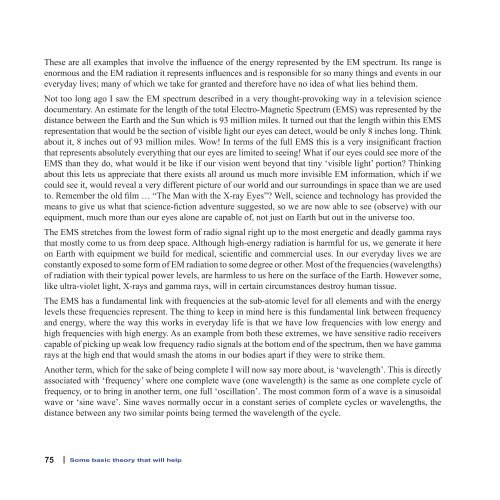A Beginner's View of Our Electric Universe - New
A Beginner's View of Our Electric Universe - New
A Beginner's View of Our Electric Universe - New
Create successful ePaper yourself
Turn your PDF publications into a flip-book with our unique Google optimized e-Paper software.
These are all examples that involve the influence <strong>of</strong> the energy represented by the EM spectrum. Its range is<br />
enormous and the EM radiation it represents influences and is responsible for so many things and events in our<br />
everyday lives; many <strong>of</strong> which we take for granted and therefore have no idea <strong>of</strong> what lies behind them.<br />
Not too long ago I saw the EM spectrum described in a very thought-provoking way in a television science<br />
documentary. An estimate for the length <strong>of</strong> the total Electro-Magnetic Spectrum (EMS) was represented by the<br />
distance between the Earth and the Sun which is 93 million miles. It turned out that the length within this EMS<br />
representation that would be the section <strong>of</strong> visible light our eyes can detect, would be only 8 inches long. Think<br />
about it, 8 inches out <strong>of</strong> 93 million miles. Wow! In terms <strong>of</strong> the full EMS this is a very insignificant fraction<br />
that represents absolutely everything that our eyes are limited to seeing! What if our eyes could see more <strong>of</strong> the<br />
EMS than they do, what would it be like if our vision went beyond that tiny ‘visible light’ portion? Thinking<br />
about this lets us appreciate that there exists all around us much more invisible EM information, which if we<br />
could see it, would reveal a very different picture <strong>of</strong> our world and our surroundings in space than we are used<br />
to. Remember the old film … “The Man with the X-ray Eyes”? Well, science and technology has provided the<br />
means to give us what that science-fiction adventure suggested, so we are now able to see (observe) with our<br />
equipment, much more than our eyes alone are capable <strong>of</strong>, not just on Earth but out in the universe too.<br />
The EMS stretches from the lowest form <strong>of</strong> radio signal right up to the most energetic and deadly gamma rays<br />
that mostly come to us from deep space. Although high-energy radiation is harmful for us, we generate it here<br />
on Earth with equipment we build for medical, scientific and commercial uses. In our everyday lives we are<br />
constantly exposed to some form <strong>of</strong> EM radiation to some degree or other. Most <strong>of</strong> the frequencies (wavelengths)<br />
<strong>of</strong> radiation with their typical power levels, are harmless to us here on the surface <strong>of</strong> the Earth. However some,<br />
like ultra-violet light, X-rays and gamma rays, will in certain circumstances destroy human tissue.<br />
The EMS has a fundamental link with frequencies at the sub-atomic level for all elements and with the energy<br />
levels these frequencies represent. The thing to keep in mind here is this fundamental link between frequency<br />
and energy, where the way this works in everyday life is that we have low frequencies with low energy and<br />
high frequencies with high energy. As an example from both these extremes, we have sensitive radio receivers<br />
capable <strong>of</strong> picking up weak low frequency radio signals at the bottom end <strong>of</strong> the spectrum, then we have gamma<br />
rays at the high end that would smash the atoms in our bodies apart if they were to strike them.<br />
Another term, which for the sake <strong>of</strong> being complete I will now say more about, is ‘wavelength’. This is directly<br />
associated with ‘frequency’ where one complete wave (one wavelength) is the same as one complete cycle <strong>of</strong><br />
frequency, or to bring in another term, one full ‘oscillation’. The most common form <strong>of</strong> a wave is a sinusoidal<br />
wave or ‘sine wave’. Sine waves normally occur in a constant series <strong>of</strong> complete cycles or wavelengths, the<br />
distance between any two similar points being termed the wavelength <strong>of</strong> the cycle.<br />
75 | Some basic theory that will help


